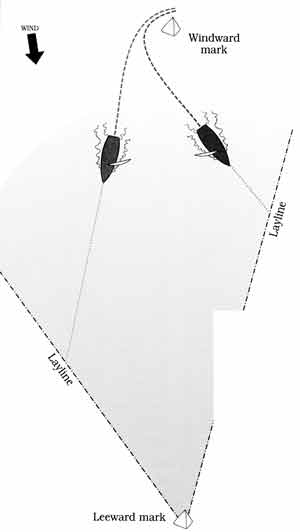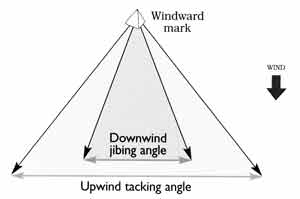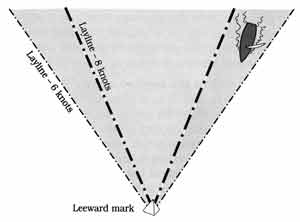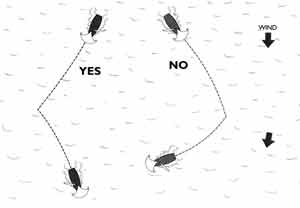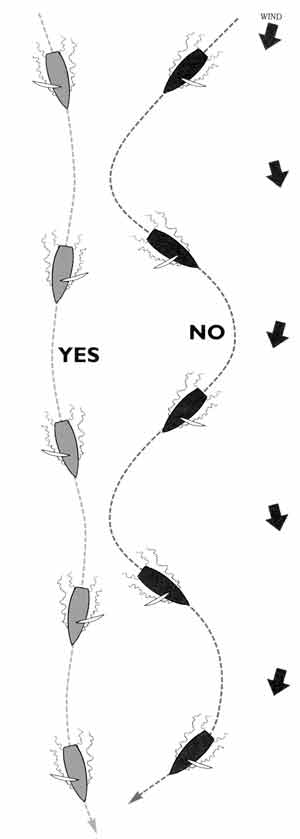Dave publishes the newsletter Speed & Smarts. For a
subscription call: 800-356-2200 or go to
www.speedandsmarts.com
Not even the best sailors know which
way to go on every downwind leg. When you’re in the “same boat”
and you aren’t sure which side of the run is favored, it’s
helpful to have a few basic strategic principles that you can
fall back on to keep yourself in the race. Here are four good
rules of thumb that will work in almost any situation. Some of
these are very similar to the strategies we have discussed for
upwind legs. Others, however, are mirror images of what you would
do on a beat!
1. Sail the longer jibe first.
The rule of thumb is a
great percentage move on beats, and it works well on runs, too,
because it keeps you away from the laylines (below). Once you get
to a layline you’re at a strategic dead end; by staying closer to
the middle you have a better chance to take advantage of whatever
windshift may come your way.
The “longer jibe” is the one on
which you will have to spend more time during the run. By sailing
this jibe first, you stay closer to the middle of the course,
more upwind of the leeward mark and farther from the laylines.
This strategy works especially well when you’re not sure what the
wind will do. It gives you a better chance of playing future
shifts and reduces your risk of overstanding the leeward mark.
Why it’s easy to overstand the
leeward mark
There are two reasons why getting too far to the sides of the
course is even more risky on a run than a beat. First, your
jibing angle is usually much narrower than your tacking angle
(above). When you have as few as 20 or 30 between jibes it’s easy
to sail past the layline to the leeward mark.
Second, changes in the wind
velocity have a much greater effect on your jibing angle than on
your tacking angle. In the example shown below, the boat was
sailing within the laylines in six knots of wind. When the wind
increased to eight knots, however, she was able to sail much
lower and thus found herself overstanding the leeward mark.
2. Sail for velocity before shifts.
It’s almost always better
to have more wind velocity when you’re racing, and this is
especially true downwind. On runs, a puff will give you better
speed through the water, and it may also let you sail quite a bit
lower. Increased wind velocity usually affects your angle much
more on a run than on a beat. For this reason, puffs on runs are
a lot like headers because they allow you to sail lower and
closer to the leeward mark. That’s why you should usually go for
pressure first downwind, especially in lighter air.
 |
3. Sail away from the next shift.
On a beat you will almost
always gain if you sail toward the next windshift because when
the shift comes you will be on a higher “ladder rung”. On a run,
the opposite is true. You should sail away from the next shift
(below) so you get to a lower ladder rung. Two times when you
probably wouldn’t want to sail away from a shift are when a) that
shift brings more wind pressure; or b) that shift allows you to
fetch the leeward mark.
4. Jibe on the lifts.
When you’re sailing
upwind, you should tack on the headers so you sail on the lifts.
On runs, however, you want to jibe on the lifts so you sail on
the headers. By staying on the headed jibe, you can sail lower
and closer to the leeward mark. Also, jibing on lifts is
consistent with rule of thumb #3 because you are sailing away
from the next shift.
In the sequence shown here, the
left boat jibes on the lifts while the right boat jibes on the
headers. You can see that the left boat sails much more directly
toward the leeward mark.
|
